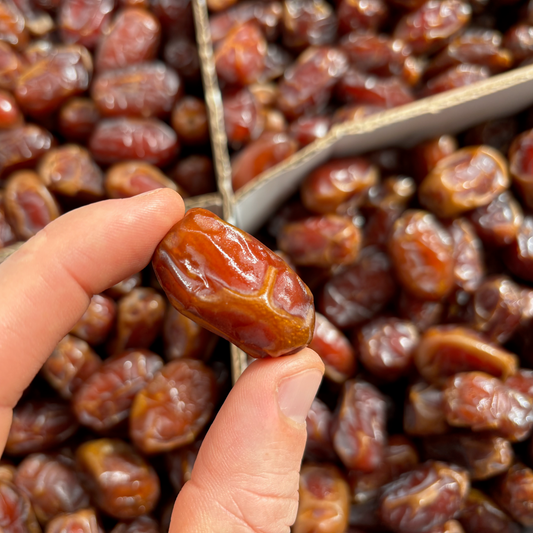fruit notes
Growing up, the weeks leading up to Lunar New Year meant pomelos started appearing in different parts of the house in anticipation of the holiday. Big, round, pink-fleshed Chandler pomelos were the usual suspects, while white-fleshed fruit like Tahitian pomelos were less common. My mother and grandmother would display the fruit on shelves, shrines, and tables around the house for weeks before we opened them to eat. The pomelos’ thick pith gives them a pretty long shelf-life, even at room temp. When we finally opened them, we’d sit around the table and peel back the tough membrane to be rewarded with juicy, plump, sweet pulp!
Pomelos are very common in Asia. Lucky for us, many of the common Asian varieties (and more) are now grown in California. (They might even have better flavor but you didn’t hear that from me!) Pomelos are pretty neat because unlike many other citrus we’re familiar with such as lemons, grapefruit, and mandarins, they are a true cultivar, not a hybrid. They are the wild ancestor to much of the citrus family: most of the citrus we enjoy today has pomelo parentage! For example, sweet oranges are a cross between pomelos and mandarins, and grapefruits are a cross between pomelos and sweet oranges. Remove the bitter membrane before eating by teasing the segments apart by hand or by suprêming with a knife, and store these on the counter. Grown organically by Murray Family Farms in Bakersfield.
I love a good white grapefruit, one that has a full flavor, sweet and tart, with its bitterness tamed. That’s a Melogold grapefruit! It’s a cross between a pomelo, which lends a relatively lower acidity, and a white grapefruit, which gives the tart, floral-fruity flavors. If you’ve ever had a true 100% white grapefruit (think Marsh grapefruit), you know they can be a lip-puckering tart! The Melogold’s name is derived from the “mellow” sweet-tart balance and the beautiful golden color that the grapefruit develops later in the season. Often harvested in early December, Melogolds are one of the earlier citrus varieties to come onto the scene. Andrew and Eric Walker of Farmboy Organics are newly tending to an older citrus orchard. Early on, they learned that the Melogolds are susceptible to being knocked off the trees by wind. But they took a risk and let the fruit hang on the tree a bit longer. This means that the golden hue really shines and the flavor has deepened immensely–delicious! Store on the counter. Grown organically by Farmboy Organics in Winters.
The Page mandarin is a cross between a clementine and a Minneola tangelo. It may be difficult to peel but the juuuicy flavor bomb is 100% worth it! We recommend quartering the mandarins and eating them like mini-orange slices. Store on the counter. Grown organically by Lagier Ranches in Escalon.
Cara Cara oranges have gotten sweeter over the holidays with just a little acidity! Juicy, sweet, with pretty-pink flesh. What’s not to like? Store on the counter. Grown organically by Murray Family Farms in Bakersfield.
Daisy mandarins are a cross between two delicious mandarins: the Fremont the and Fortune. If you were around last spring, we brought in Fremont mandarins from Garcia Family Farm and we were crazy about them! So it makes sense why the Daisy mandarin has taken off in citrus world. They are sweet with a refreshing tang, and super flavorful. Store on the counter. Grown organically by Murray Family Farm in Bakersfield.
These Red kiwifruit are new to California in the last few years! Their vanilla manila exterior belies their supremely novel flavor. They have berry flavors and they're uniquely subacid for a kiwi. And they are so tasty! Store on the counter. Grown organically by Wild River Fruit in Marysville.





